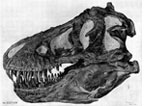  Dinosaur Fossils, Eggs & More Dinosaur Fossils, Eggs & More
Learn about dinosaur fossils, eggs, bones and skeletons with our fun facts for kids. While dinosaurs became extinct long before us humans were around, fossils and modern science have helped us learn a lot about what they might have been like. Read on and enjoy a wide range of cool facts and information about fossilized dinosaur eggs, tail spikes, footprints and more. | | |
Dinosaur fossils have been found on every continent of Earth, including Antarctica. Fossils help us understand what the dinosaurs were like. Information can be gathered from sources such as fossilized bones, footprints, stomach stones, feces, internal organs, soft tissues, eggs and feathers. Over 1000 different species of dinosaurs have been named and the list continues to grow as new fossils are discovered. Some of the largest fossilized dinosaur eggs ever discovered were found in China in the mid 1990’s. The eggs are over 60cm (2ft) long and 20cm (8in) wide. The tail of the Diplodocus is believed to have been made up of around 80 vertebrae. The most common form of Stegosaurus featured four tail spikes which were used to combat carnivores (meat eaters) such as the Allosaurus. Dinosaur fossils have been known for a long time in human history but it wasn’t until the early 19th century that they were formally recognized as the dinosaurs we learn about today. When English paleontologist Richard Owen coined the term ‘dinosaur’ in 1842 he based the name on the remains that had been discovered at that time, which included the Megalosaurus, Iguanodon and Hylaeosaurus. These remains shared distinctive features which led Owen to label them as a distinct group, different from other species known at the time. In 1858, one of the first almost complete dinosaur skeletons was discovered in New Jersey. What made this discovery special was that it was a bipedal dinosaur, meaning one that moved on two legs. Most scientists had previously thought that all dinosaurs moved on four feet. The discovery dramatically changed views and led to a huge increase in dinosaur interest among those living in the USA. In 1868 the bones of a Hadrosaurus were used to create the first ever mounted dinosaur skeleton. - For more, check out our picture gallery of interesting dinosaur fossils, bones, skeletons and eggs.
| | | | | | | | More Dinosaur Facts! | | | | | | | | | | | | | | | | | | | Fossils, Eggs etc | |
|
|